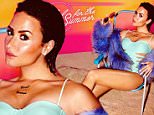Bi-racial Teen Vogue editor hits back after coming under fire for decision to use a 'light-skinned' model in a feature about an African hairstyle
- Teen Vogue received online criticism from readers over the lack of dark-skinned models used to illustrate a feature on Senegalese twists
- The hairstyle is most commonly associated with African Americans, but Teen Vogue opted to use a light-skinned model in its feature
- In a new essay, the editor who wrote the piece defended the decision, and pointed out that the model is actually of mixed race
- The editor, who is biracial herself, noted that the fashion and beauty industries still have a long way to go to be inclusive of women of color
A Teen Vogue editor who faced a severe online backlash after she opted to use a light-skinned model to illustrate a feature about African-American hairstyles has penned an open letter to her critics in which she defends her controversial decision.
The June/July issue of the popular teen publication features an article by the magazine's beauty and health director Elaine Welteroth, in which she writes about having her hair braided in Rwanda and the reaction she received upon her return to New York City. Since its publication, readers have taken to social media to express their frustration with the magazine for excluding black models from the feature; the featured model in the piece has light skin, while many of the other women used to illustrate the Senegalese twists style were white.
Now, Ms. Welteroth has penned an essay defending her choice, as well as noting that the piece has opened a discussion about race.

Talking 'bout tresses: The latest issue of Teen Vogue has received backlash over the lack of dark-skinned models used to illustrate a feature on Senegalese twists, a hairstyle popular among African American women

All-inclusive: The article's author, editor Elaine Welteroth (pictured), wrote in a new essay that she chose a model who is biracial to demonstrate that there is a broad spectrum of what 'black' looks like
While a version of the article online features photos of Welteroth, who is herself of mixed race, the print version used photos of a model named Phillipa Steele.
Phillipa, Ms. Welteroth wrote, is of mixed race as well - just like singer and actress Zendaya, who inspired the piece on Senegalese twists by wearing dreadlocks to the Oscars earlier this year.
'Phillipa Steele... strikes an uncanny resemblance to Zendaya, the story's hero,' she wrote, noting that Zendaya used her platform to shed light 'on the importance of debunking harmful stereotypes linked to ethnic hairstyles'.
With this piece, Ms. Welteron was hoping to do the same. But because she used a 'racially ambiguous' model, whom many readers assumed was white because of her light skin, the message seems to have gotten lost.

Not as it seems: Although this Twitter user called her a 'white girl', the model used to illustrate the feature is actually biracial

In need of diversity? The article include a photo of Zoe Kravitz, center, but many complained about the lack of dark-skinned women to help illustrate a hairstyle most commonly associated with African Americans

Feeling under-represented: Some angry readers accused Teen Vogue of being 'anti-black'

Calling casting into question: A number of other people also took to social media to voice their unhappiness at Teen Vogue for only using the 'lightest-skinned black' models
'F*** @TeenVogue for their bulls*** article about Senegalese twists and only showing one black girl for example! How could you!!!! [sic]' tweeted @JOJOTHAJAWN, as first reported by BuzzFeed.
'Seriously not buying @TeenVogue again. I'm so insulted by this! You interview a White girl about African hairstyles!! [sic]' she continued.
While the magazine also used photos of several black celebrities in the piece, including Zendaya and Zoe Kravitz, several readers also took issue with the lack of darker-skinned black women.
'It's bad enough that your cheap ass mag barely has any BW [black women] but the ONE time you should, you don't deliver. @TeenVogue,' said one.
'Why's your magazine so anti black?' tweeted @amberjhails.
Other Twitter users accused the magazine of 'appropriating protective hairstyles' and picking the 'lightest-skinned black' people.
'There is rarely black women on Teen Vogue and one time it is completely necessary, you have your generic white girls in BW hairstyles,' complained @niaisasquare.

Outrage: Some Twitter users said that the magazine was 'appropriating' black hair styles for white women - though neither the editor nor the model featured in the story are white

Thoughtful explanation: Ms. Welteroth, who wrote the article, defended the choice of model on her Instagram page before writing a more in-depth response on Teen Vogue's website
Ms. Welteroth initially attempted to defend the choice of model on her Instagram page, writing: 'How do you define black? Just curious. Is it about skin color? Eye color? Hair texture? I ask because this mixed-race model is as black as I am. [sic]'
In her essay, Ms. Welteroth said that she understood why images of a light-skinned girl wearing the Afrocentric hairstyle would strike a chord - especially when taken out of context.
'I will be the first to say that the industry still has a long way to go in addressing the deep need for more affirming messages that reinforce the fact that [a girl of color] is beautiful and that she matters,' she wrote. 'As one of few black beauty editors, it is a responsibility that I do not take lightly.'
She explained that she, too, understands what it's like to feel 'overlooked' and 'disregarded' - but she also takes issue with the idea that she, or the biracial model featured, are 'not black enough'.
'Black comes in a myriad of colors and textures - all of them beautiful, all of them deserving of representation,' she continued. 'In the telling of this particular story, which is my own personal story, it was important to me to include a model that is also mixed-race (she is Black and French).'
Ms. Welteroth, the model Phillipa, and celebrities like Zendaya represent 'a broadening spectrum of what Black looks like', she said - and she hopes that her story and the discussions about it lead to more open ideas about race and how it is defined.
-
 Dramatic moment Queen's Guard pulls rifle on tourist
Dramatic moment Queen's Guard pulls rifle on tourist
-
 Holiday maker captures terror from hotel room in Tunisia
Holiday maker captures terror from hotel room in Tunisia
-
 Gunman shot dead by security services in Tunisia
Gunman shot dead by security services in Tunisia
-
 Horrifying amateur footage of Tunisia attacks unfolding
Horrifying amateur footage of Tunisia attacks unfolding
-
 Eight-foot wide giant vortex appears on Lake Texoma
Eight-foot wide giant vortex appears on Lake Texoma
-
 Shocking moment girl and baby dragged to ground in fight
Shocking moment girl and baby dragged to ground in fight
-
 Obama sings Amazing Grace after eulogy to Rev Pinckney
Obama sings Amazing Grace after eulogy to Rev Pinckney
-
 Chinese students caught having sex in the street
Chinese students caught having sex in the street
-
 Officer locks passenger between legs after tasering him
Officer locks passenger between legs after tasering him
-
 Bodies of victims are covered up on the beach in Sousse
Bodies of victims are covered up on the beach in Sousse
-
 Bobby Brown visits Bobbi Kristina's hospice in Georgia
Bobby Brown visits Bobbi Kristina's hospice in Georgia
-
 Groom's heartwarming reaction as bride walks down aisle
Groom's heartwarming reaction as bride walks down aisle
-
 Hundreds of heavily-armed cops circle on second 'Shawshank'...
Hundreds of heavily-armed cops circle on second 'Shawshank'...
-
 Horror on the beach: At least eight Britons confirmed dead...
Horror on the beach: At least eight Britons confirmed dead...
-
 The 'handsome gorilla' driving Japanese girls mad:...
The 'handsome gorilla' driving Japanese girls mad:...
-
 First picture emerges of man beheaded in French terror...
First picture emerges of man beheaded in French terror...
-
 States halt Washington pride: Same-sex couples rush to marry...
States halt Washington pride: Same-sex couples rush to marry...
-
 Dramatic moment Queen's Guard soldier turned rifle on...
Dramatic moment Queen's Guard soldier turned rifle on...
-
 Obama's amazing grace: President gives searing speech on...
Obama's amazing grace: President gives searing speech on...
-
 As scary as she is sexy: Maria Sharapova has a touch of the...
As scary as she is sexy: Maria Sharapova has a touch of the...
-
 EXCLUSIVE: Tear off the white hood - Obama wants KKK to be...
EXCLUSIVE: Tear off the white hood - Obama wants KKK to be...
-
 'Just go, tell our children that their daddy loves them':...
'Just go, tell our children that their daddy loves them':...
-
 EXCLUSIVE: A sanctuary of peace for Bobbi Kristina's last...
EXCLUSIVE: A sanctuary of peace for Bobbi Kristina's last...
-
 The battlefields of the Civil War then and now: Pictures...
The battlefields of the Civil War then and now: Pictures...





























































































































































































































































































































